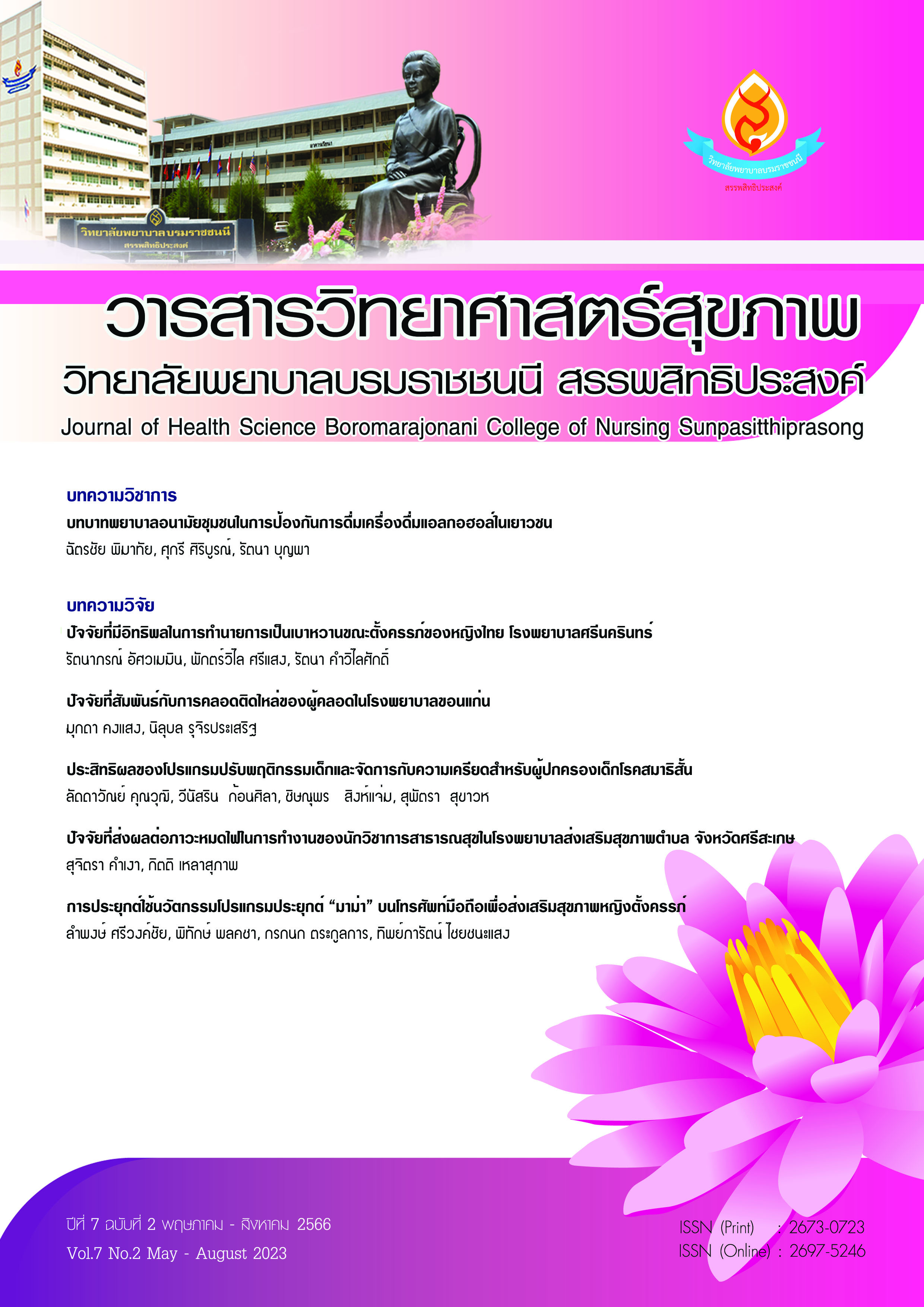ปัจจัยที่สัมพันธ์กับการคลอดติดไหล่ของผู้คลอดในโรงพยาบาลขอนแก่น
คำสำคัญ:
คลอดติดไหล่, ปัจจัยเสี่ยง , ดัชนีมวลกายก่อนตั้งครรภ์ , ทารกตัวโต , เบาหวานขณะตั้งครรภ์บทคัดย่อ
การคลอดติดไหล่เป็นภาวะฉุกเฉินทางสูติศาสตร์ที่ไม่สามารถคาดการณ์ได้ สาเหตุของการเกิดยังไม่ทราบแน่ชัด อัตราการเกิดไม่สูงมากแต่ภาวะแทรกซ้อนที่มีต่อมารดาและทารกค่อนข้างรุนแรง การศึกษาเชิงวิเคราะห์แบบมีกลุ่มควบคุมและไม่จับคู่นี้ มีจุดประสงค์เพื่อศึกษาปัจจัยที่สัมพันธ์กับการคลอดติดไหล่ในผู้ที่มาคลอดบุตรในโรงพยาบาลขอนแก่น โดยเก็บข้อมูลย้อนหลังจากแฟ้มข้อมูลผู้คลอดระหว่างวันที่ 1 ตุลาคม พ.ศ. 2553 ถึง 30 กันยายน พ.ศ. 2563 ในกลุ่มผู้คลอดที่มีการคลอดติดไหล่จำนวน 163 ราย และกลุ่มผู้คลอดที่ไม่มีการคลอดติดไหล่ จำนวน 326 ราย วิเคราะห์ข้อมูลโดยใช้สถิติเชิงพรรณนา สถิติถดถอยโลจิสติก และสถิติถดถอยเชิงพหุวิเคราะห์ปัจจัยแบบหลายตัวแปร ผลการวิจัยพบว่าปัจจัยที่มีความสัมพันธ์กับการคลอดติดไหล่อย่างมีนัยสำคัญทางสถิติ ประกอบด้วย 4 ปัจจัย คือ ดัชนีมวลกายก่อนการตั้งครรภ์ (aOR = 3.94, 95%CI 1.34-11.58) ผู้คลอดที่เป็นเบาหวาน (aOR = 5.37, 95% CI 1.58-28.23) การช่วยคลอดด้วยสูติศาสตร์หัตถการ (aOR = 13.251, 95%CI 5.32-32.99) และทารกตัวโต (aOR = 49.33, 95%CI 6.19-392.79) พยาบาลผดุงครรภ์ควรส่งเสริมหญิงตั้งครรภ์หรือผู้หญิงที่วางแผนจะตั้งครรภ์ให้ควบคุมน้ำหนักและการรับประทานอาหารที่เหมาะสมเพื่อป้องกันภาวะอ้วน และการเป็นเบาหวานขณะตั้งครรภ์ นอกจากนั้นพยาบาลผดุงครรภ์ควรเน้นการคัดกรองและประเมินขนาดและน้ำหนัก ของทารกเมื่อเข้าสู่ระยะคลอด เพื่อลดความเสี่ยงในการคลอดติดไหล่
เอกสารอ้างอิง
American College of Obstetricians and Gynecologists.Replaces Practice Bulletin Number 40, November 2002: Shoulder Dystocia. Obstetrics & Gynecology 2017;129:e124-32.
Hansen A, Chauhan SP. Shoulder dystocia: Definitions and incidence. Semin Perinatol. 2014;38:184–8.
Cheng YKY, Lao TT, Sahota DS, Leung VKT, Leung TY. Use of birth weight threshold for macrosomia to identify fetuses at risk of shoulder dystocia among Chinese populations. Int J Gynecol Obstet 2013;120:249–53.
โรงพยาบาลขอนแก่น. รายงานสถิติประจำปีห้องคลอดของโรงพยาบาลขอนแก่น. ขอนแก่น: โรงพยาบาลขอนแก่น; 2562.
Dajani NK, Magann EF. Complications of shoulder dystocia. Semin Perinatol 2014;38:201-4.
Beck CT. The Obstetric Nightmare of Shoulder Dystocia: A Tale from Two Perspectives. MCN Am J Matern Nurs 2013;38:34–40.
Weissmann-Brenner A, Simchen MJ, Zilberberg E, Kalter A, Weisz B, Achiron R, et al. Maternal and neonatal outcomes of large for gestational age pregnancies: Outcomes of large for gestational age pregnancies. Acta Obstet Gynecol Scand 2012;91:844–9.
Volpe KA, Snowden JM, Cheng YW, Caughey AB. Risk factors for brachial plexus injury in a large cohort with shoulder dystocia. Arch Gynecol Obstet 2016;294:925–9.
Karahanoglu E, Kasapoglu T, Ozdemirci S, Fadıloglu E, Akyol A, Demirdag E, et al. Risk factors for clavicle fracture concurrent with brachial plexus injury. Arch Gynecol Obstet 2016;293:783–7.
Leung T, Stuart O, Sahota D, Suen S, Lau T, Lao T. Head-to-body delivery interval and risk of fetal acidosis and hypoxic ischaemic encephalopathy in shoulder dystocia: a retrospective review: Head-to-body delivery interval in shoulder dystocia. BJOG Int J Obstet Gynaecol 2011;118:474–9
Zhang C, Wu Y, Li S, Zhang D. Maternal prepregnancy obesity and the risk of shoulder dystocia: a meta-analysis. BJOG Int J Obstet Gynaecol 2018;125:407–13.
Gherman RB, Chauhan S, Ouzounian JG, Lerner H, Gonik B, Goodwin TM. Shoulder dystocia: The unpreventable obstetric emergency with empiric management guidelines. Am J Obstet Gynecol 2006;195:657–72.
Kleitman V, Feldman R, Walfisch A, Toledano R, Sheiner E. Recurrent shoulder dystocia: is it predictable? Arch Gynecol Obstet. 2016;294:1161–6.
Youssefzadeh AC, Tavakoli A, Panchal VR, Mandelbaum RS, Ouzounian JG, & Matsuo K. Incidence trends of shoulder dystocia and associated risk factors: A nationwide analysis in the United States. International Journal of Gynecology & Obstetrics 2023;162:578–89.
Mehta SH, Sokol RJ. Shoulder dystocia: Risk factors, predictability, and preventability. Semin Perinatol 2014;38:189–93.
Kominiarek MA, Saade G, Mele L, Bailit J, Reddy UM, Wapner RJ, et al. Association Between Gestational Weight Gain and Perinatal Outcomes. Obstet Gynecol 2018;132:875–81.
Feig DS, Hwee J, Shah BR, Booth GL, Bierman AS, Lipscombe LL. Trends in Incidence of Diabetes in Pregnancy and Serious Perinatal Outcomes: A Large, Population-Based Study in Ontario, Canada, 1996–2010. Diabetes Care 2014;37:1590–6.
Henry DE, Cheng YW, Shaffer BL, Kamala AJ, Bianco K, & Caughey AB. Perinatal Outcomes in the Setting of Active Phase Arrest of Labor. Obstetric Anesthesia Digest 2009;29:187.
Harper LM, Caughey AB, Roehl KA, Odibo AO, Cahill AG. Defining an abnormal first stage of labor based on maternal and neonatal outcomes. Am J Obstet Gynecol 2014;210:536.e1-536.e7.
Revicky V, Mukhopadhyay S, Morris EP, Nieto JJ. Can we predict shoulder dystocia?. Arch Gynecol Obstet 2012;285:291–5.
Overland EA, Vatten LJ, Eskild A. Risk of shoulder dystocia: associations with parity and offspring birthweight. A population study of 1 914 544 deliveries. Acta Obstet Gynecol Scand 2012;90:483-8. doi: https://doi.org/10.1111/j.1600-0412.2011.01354.x
Santos P, Hefele JG, Ritter G, Darden J, Firneno C, Hendrich A. Population-Based Risk Factors for Shoulder Dystocia. J Obstet Gynecol Neonatal Nurs 2018;47:32–42.
Robinson H, Tkatch S, Mayes DC, Bott N, Okun N. Is maternal obesity a predictor of shoulder dystocia?. Obstet Gynecol 2003;101:24-7. PMID: 12517641.
Overland E, Vatten L, Eskild A. Pregnancy week at delivery and the risk of shoulder dystocia: a population study of 2 014 956 deliveries. BJOG Int J Obstet Gynaecol 2014;121:34–42.
Tsur A, Sergienko R, Wiznitzer A, Zlotnik A, Sheiner E. Critical analysis of risk factors for shoulder dystocia. Arch Gynecol Obstet 2012;285:1225–9
Yeo GS, Lim YW, Yeong CT, Tan TC. An analysis of risk factors for the prediction of shoulder dystocia in 16,471 consecutive births. Ann Acad Med Singapore 1995;24:836–40.
Patumanond J, Tawichasri C, Khunpradit S. Infant male sex as a risk factor for shoulder dystocia but not for cephalopelvic disproportion: an independent or confounded effect?. Gend Med 2010;7:55-63. doi: 10.1016/j.genm.2010.01.001. PMID: 20189155.
อรุณ จิรวัฒน์กุล. สถิติทางวิทยาศาสตร์สุขภาพเพื่อการวิจัย. กรุงเทพฯ: วิทยพัฒน์; 2558.
Gilmore LA, Redman LM. Weight gain in pregnancy and application of the 2009 IOM guidelines: Toward a uniform approach. Obesity 2015;23:507–11.
Cosson E, Cussac-Pillegand C, Benbara A, Pharisien I, Nguyen MT, Chiheb S, et al. Pregnancy adverse outcomes related to pregravid body mass index and gestational weight gain, according to the presence or not of gestational diabetes mellitus: A retrospective observational study. Diabetes Metab 2016;42:38–46.
Plows JF, Stanley JL, Baker PN, Reynolds CM, Vickers MH. The Pathophysiology of Gestational Diabetes Mellitus. Int J Mol Sci 2018;19:3342.
Macrosomia: ACOG Practice Bulletin Summary, Number 216. Obstet Gynecol 2020;135:246-248. doi: 10.1097/AOG.0000000000003607. PMID: 31856119.
Youssef AEA, Amin AF, Khalaf M, Khalaf MS, Ali MK, Abbas AM. Fetal biacromial diameter as a new ultrasound measure for prediction of macrosomia in term pregnancy: aprospective observational study. J Matern Fetal Neonatal Med 2019;32:2674–9.
รพีพรรณ วิบูลย์วัฒนกิจ. บท 7 องค์ประกอบ กลไก และการคลอดปกติ [อินเตอร์เน็ต]. ม.ป.ป. [เข้าถึงเมื่อ 20 ต.ค. 2563]. เข้าถึงได้จาก: https://online.pubhtml5.com/gezu/ssdn/#p=1
ดาวน์โหลด
เผยแพร่แล้ว
รูปแบบการอ้างอิง
ฉบับ
ประเภทบทความ
สัญญาอนุญาต
ลิขสิทธิ์ (c) 2023 วิทยาลัยพยาบาลบรมราชชนนี สรรพสิทธิประสงค์

อนุญาตภายใต้เงื่อนไข Creative Commons Attribution-NonCommercial-NoDerivatives 4.0 International License.
บทความที่ได้รับการตีพิมพ์เป็นลิขสิทธิ์ของวารสารวิทยาศาสตร์สุขภาพ วิทยาลัยพยาบาลบรมราชชนนี สรรพสิทธิประสงค์ ข้อความที่ปรากฏในบทความแต่ละเรื่องเป็นความคิดเห็นส่วนตัวของผู้เขียนแต่ละท่านไม่เกี่ยวข้องกับวิทยาลัยพยาบาลบรมราชชนนี สรรพสิทธิประสงค์ และคณาจารย์ท่านอื่นๆ ในวิทยาลัยพยาบาลฯ ความรับผิดชอบเกี่ยวกับบทความแต่ละเรื่องผู้เขียนจะรับผิดชอบของตนเอง



